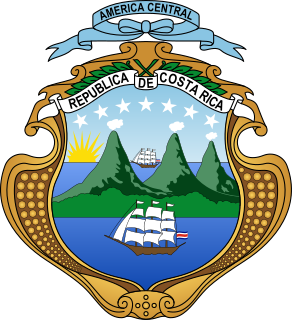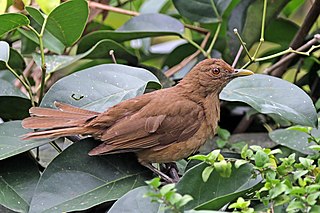 W
WThe official coat of arms of the Republic of Costa Rica was designed in 1848, with modifications in 1906, 1964, and 1998. The latest change was the addition of smoke to distinguish the three volcanoes.
 W
WEnterolobium cyclocarpum, commonly known as guanacaste, caro caro, monkey-ear tree or elephant-ear tree, is a species of flowering tree in the pea family, Fabaceae, that is native to tropical regions of the Americas, from central Mexico south to northern Brazil (Roraima) and Venezuela. It is known for its large proportions, its expansive, often spherical crown, and its curiously shaped seedpods. The abundance of this tree, especially in Guanacaste Province, Costa Rica, where it is prized for the shady relief it provides from the intense sun, coupled with its immensity, have made it a widely recognized species. It is the national tree of Costa Rica.
 W
WThe national flag of Costa Rica is based on a design created in 1848. The state flag is also used as the official ensign, and includes the coat of arms of Costa Rica. The civil ensign omits the coat of arms, since the flag with the coat of arms is only permitted to be used by the government.
 W
WGuarianthe skinneri is a species of orchid. It is native to Costa Rica; from Chiapas to every country in Central America.
 W
WLas carretas, Costa Rican oxcarts, are a large part of Costa Rican history. They allowed for the expansion and increase of exports of many goods including Costa Rica's main export, coffee. It also is a huge part of Costa Rican culture today. The oxcarts are considered one of Costa Rica's national symbols.
 W
WThe "Himno Nacional de Costa Rica", also known by its incipit "Noble patria, tu hermosa bandera" is the national anthem of Costa Rica. The song was originally adopted in 1853, with the music composed by Manuel María Gutiérrez. Words by José María Zeledón Brenes were added in 1900.
 W
WJuan Santamaría Rodríguez was a drummer in the Costa Rican army, officially recognized as the national hero of his country for his actions in the 1856 Second Battle of Rivas, in the Filibuster War. He died in the battle carrying a torch he used to light the enemy stronghold on fire, securing a victory for Costa Rica against American mercenary William Walker and his imperialist forces. Thirty five years after his death, he began to be idealized and was used as a propaganda tool to inspire Costa Rican nationalism. A national holiday in Costa Rica, Juan Santamaría Day, is held annually on April 11th to commemorate his death.
 W
WThe clay-colored thrush is a common Middle American bird of the thrush family (Turdidae). It is the national bird of Costa Rica, where it is well known as the yigüirro. Other common names include clay-colored robin.
 W
WThe white-tailed deer, also known as the whitetail or Virginia deer, is a medium-sized deer native to North America, Central America, Ecuador, and South America as far south as Peru and Bolivia. It has also been introduced to New Zealand, all the Greater Antilles in the Caribbean, and some countries in Europe, such as the Czech Republic, Finland, Romania, Serbia, Germany, and France. In the Americas, it is the most widely distributed wild ungulate.